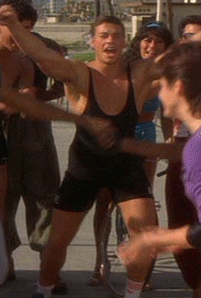The main theme of the workshop was that there is no one size fits all approach to fitness. In order to achieve your goals you need to figure out what works for you, or have a professional figure it out for you. But we need to understand the underlying principles in order to do this.
Among the main coaches present were Mike Mahler, Steve Cotter, "Stone Cold" Ken Blackburn, Jason Dolby, Andrew Durniat, and John Wild Buckley. And I must thank Mike Mahler for kindly allowing me to attend and help out when needed.
Each of these individuals has a unique background, skill set, knowledge base, and specialty. And together they made a hell of a group to lead a well rounded approach to fitness and well being.
Ken Blackburn lead the dynamic warmup/mobility and agility portions each day - and there were plenty of people dog tired after the initial hour of agility training, and we hadn't even lifted anything yet! Some of this mobility work would be familiar to martial artists, but not generally what one sees trainers do, something I think could use some reflecting upon. People with MA backgrounds tend to move very well and have good mobility and flexibility, so why not incorporate more of what they do?
It is even whispered in some circles that some of Ken's moves were derived from the legendary Jean Claude Van Damme himself!

Mike Mahler's presentations focused on nutrition, supplementation, and how this affects our hormones and ultimately our health. He drew on a number of sources including Dr. Kessler's excellent The End Of Overeating. Mike's main message was derive as much of our nutrients as possible from clean, organic sources, and understand exactly what supplementation an individual may need to our optimize hormonal profile.
Jason Dolby lead and excellent segment on Indian club work for shoulder health on days 1 & 3. Clubs have been around a long time but are highly underrated in my opinion. Clubs have already been implemented into some of my clients training. Try it, your shoulders will thank you.
Day 2 focused primarily on kettlebell the kettlebell sport lifts and assistance work. The group spent a good 6 hours on working cleans, jerks, snatches, long cycle, and related drills. We performed a number of work sets in order to develop technique and show what sort of programming works for various purposes. The coaches made sure to present a variety of approaches to each movement, stressing that certain ways work better for certain builds, and that everyone should experiment and find what works for them. Not unlike powerlifting or any other sport.
We were fortunate to have Andrew Durniat lead the snatch portion. Andrew quite a knowledgeable guy, and has competed in Russia at the highest levels of KB sport, as well as strongman competitions and a winner of the 2009 national grip strength competition. That's him doing the KB and barbell juggling in the video below.
Following KB work there was a panel discussion during which various aspects of programming and periodization, including KB sport work, integrating Wendler's 5/3/1, integrating KBs into general fitness programs, and other concepts.
Following warm ups and mobility work on day 3, Steve Cotter was ready to open some eyes with bodyweight conditioning work derived from Chinese martial arts. Some of the drills had people muttering "no way in hell" but Steve is a great teacher and instructed how to regress each movement so that everyone could do it.
After an hour of this we ended the segment with 50 dragon twist squats. I don't know if many people made it through all 50, but we tried. And we still had the squat segment coming up. Uh oh.
Mike and Ken lead the pressing segment, assisted by John Wild, who's build is indeed well suited to wrestling dinosaurs. Despite having some back spasms John can throw a 150lbs overhead with one arm like you might lift a pencil.
Go ahead an youtube John Wild.
One topic discussed here and in the KB jerk portion is the role of thoracic mobility, and the ability to utilize thoracic extension, the ribcage, and the back in overhead movements. This concept is not very widely practiced in the West, but we could all feel an immediate difference in pressing.
Yet another reason to do foam rolling and other types of back mobility work.
Steve Cotter came back and put everyone through some great squat mobility work. This is something I find every single client needs alot of, and if you sit in a chair for more than a few hours a day you need it to.
Steve ended this portion with a squat drill that consisted of 8 sets of 10 double KB squats with minimal rest. Starting from the heaviest pair we worked our way down each set until we could barely squat our own bodyweight. My legs still remember you Steve, thanks. I guess.
Andrew Durniat ended the day with an exhibition of barbell and kettlebell juggling. He is an admirer of the deep history of physical culture, and digs these sorts of odd lifts and feats of strength. Great stuff and fun movements to play with.
All in all this was probably the best workshop I've attended, and all involved did a fantastic job. I can't express enough how cool it was to spend 8 hours each day surrounded by people so focused on physical culture and fitness - a rare treat in a time of gyms filled with chrome junk and cookie cutter training. I'm already looking forward to the next opportunity to get together with my clan.



